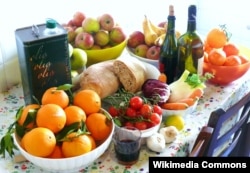From VOA Learning English, this is the Health & Lifestyle report.
In the United States, fad diets come and go. It is sometimes hard to keep track of them all. However, one diet that always makes the list of healthiest is the Mediterranean Diet.
Well, now it has competition from the New Nordic Diet.
The New Nordic Diet comes from the part of Northern Europe that includes Finland, Norway, Iceland, Sweden and Denmark. This area is sometimes called Scandinavia.
Diet experts at Health.com explain that the New Nordic and the Mediterranean diets are quite similar. In fact, they were compared in a 2015 study. The study found that the New Nordic Diet reduced inflammation within fat tissue. This type of inflammation is linked to obesity-related health risks.
Both diets include lots of vegetables and fruits; whole grains; nuts and seeds; and more seafood than meat.
However, one big difference between the two is the choice of oil. The Mediterranean Diet uses olive oil. Olives are not grown in Scandinavia. So, canola, or rapeseed, oil is more common there.
And that leads us to the heart of the New Nordic Diet. It considers the environment and food preparation.
So, it is rich in food that is local and seasonal. As much as is possible, the New Nordic centers on fresh foods that are grown, raised or caught where you live. What you can find in the forests -- wild mushrooms, berries and herbs -- are all important to this diet. Also found in this diet are lots of root vegetables such as parsnips, carrots and beets.
The New Nordic Diet centers around home cooked meals. Restaurant meals can be higher in fat and calories.
Eating better quality food but less of it is also part of this diet. It avoids processed foods – generally mass-produced foods that come already cooked and packaged. It stresses eating organic foods whenever possible and creating less waste as we cook and eat.
The New Nordic is also an eco-friendly diet. It is more of a lifestyle -- a way of living and eating -- rather than a list of foods you can or cannot eat. Because it centers around local foods, it should not be surprising that fish is a main part of the New Nordic Diet.
Health experts on the Berkeley Wellness website say that people who eat fish "tend to live longer and enjoy lower risks of cardiovascular disease." They add that eating fish may even boost a person’s brain health. Fish, they say, "contains vitamins, minerals, and other fats that may work with the omega-3s to protect the heart and overall health."
But these experts also warn that it is important to eat the right kind of fish. Some are high in mercury. So, they advise eating smaller fish. They are "lower on the food chain." And if you catch the fish yourself, make sure and check with local experts to make sure the water quality is healthy.
The website suggests that anchovies, sardines, cod, shrimp and salmon are among the best choices. They say to avoid bigger fish such as shark and swordfish because they contain more mercury.
Also on the Berkeley Wellness website, diet experts make other suggestions about which fish to eat.
And that's the Health & Lifestyle report. I'm Anna Matteo.
Best choices (2 to 3 servings a week)
anchovies, black sea bass, butterfish, catfish, clams, cod, crab, crawfish, croaker (Atlantic), flounder, haddock, hake, herring, lobster, mullet, oyster, mackerel (Atlantic or Pacific chub), perch, pickerel, plaice, pollock, salmon, sardines, scallops, shad, shrimp, skate, smelt, sole, squid, tilapia, trout, tuna (canned light), whitefish, whiting
Good choices (only once a week)
bluefish, buffalo fish, carp, Chilean sea bass, croaker (Pacific), grouper, halibut, mahi mahi, monkfish, rockfish, sablefish, sheepshead, snapper, Spanish mackerel, striped bass, tilefish (Atlantic), tuna (albacore or yellowfin, canned or fresh), weakfish
Avoid (because of mercury)
bigeye tuna, king mackerel, marlin, orange roughy, shark, swordfish, tilefish (Gulf of Mexico)
Anna Matteo wrote this story for VOA Learning English. Caty Weaver was the editor.
______________________________________________________________
_____________________________________________________________
Words in This Story
fad diet – n. a way of eating that promises weight loss or other health advantages, such as longer life, and usually relies on pseudoscience rather than science to make many of its claims : In many cases, a fad diet has highly restrictive or unusual food choices
inflammation – medical noun a condition in which a part of your body becomes red, swollen, and painful
obesity – medical noun a condition that is characterized by excessive accumulation and storage of fat in the body and that in an adult is typically indicated by a body mass index of 30 or greater
packaged – v. to enclose in a package or covering
organic – adj. of food : grown or made without the use of artificial chemicals
cardiovascular disease – medical noun Cardiovascular disease generally refers to conditions that involve narrowed or blocked blood vessels that can lead to a heart attack, chest pain (angina) or stroke.
omega-3 – medical n. being or composed of polyunsaturated fatty acids in which the first double bond in the hydrocarbon chain occurs between the third and fourth carbon atoms from the end of the molecule most distant from the carboxylic acid group and which are found especially in fish (as tuna and salmon), fish oils, green leafy vegetables, and some vegetable oils
mercury – n. a silver metal that is liquid at normal temperatures
food chain – n. a series of types of living things in which each one uses the next lower member of the series as a source of food











